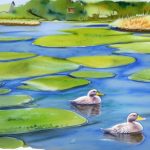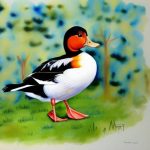Arkansas is known for its rich history and diverse wildlife, including a variety of duck breeds that are native to the region. These duck breeds have been an integral part of Arkansas’s culture and economy for centuries, serving as both a source of food and a popular game bird for hunting enthusiasts. Arkansas duck breeds are prized for their unique characteristics and physical traits, making them a popular choice for both hunting and farming purposes. In this article, we will explore the history, origins, characteristics, popular breeds, care and maintenance, as well as the challenges and health issues of Arkansas duck breeds. By understanding the significance of these duck breeds, we can appreciate their contribution to Arkansas’s heritage and ensure their preservation for future generations.
Key Takeaways
- Arkansas is home to several unique duck breeds that are popular for hunting and farming.
- The history and origins of Arkansas duck breeds can be traced back to the early 1900s when they were developed for their adaptability and hardiness.
- Arkansas duck breeds are known for their distinctive physical traits, including their size, coloration, and feather patterns.
- Popular Arkansas duck breeds for hunting and farming include the Khaki Campbell, the Indian Runner, and the White Crested.
- Proper care and maintenance, including providing a suitable habitat, nutrition, and regular health checks, are essential for the well-being of Arkansas duck breeds.
History and Origins of Arkansas Duck Breeds
The history of Arkansas duck breeds dates back to the early days of the state’s settlement, when European settlers brought domesticated ducks with them to the region. Over time, these domesticated ducks interbred with wild ducks native to Arkansas, resulting in the development of unique duck breeds that are well-adapted to the state’s diverse ecosystems. Arkansas’s abundant wetlands, rivers, and lakes provided the perfect habitat for these duck breeds to thrive, leading to their widespread popularity among hunters and farmers alike. The rich hunting tradition in Arkansas further contributed to the preservation and propagation of these duck breeds, as they were selectively bred for their desirable traits such as size, plumage, and foraging abilities. Today, Arkansas is home to several distinct duck breeds that have become synonymous with the state’s outdoor heritage and are highly sought after by enthusiasts and conservationists alike.
Characteristics and Physical Traits of Arkansas Duck Breeds
Arkansas duck breeds are known for their distinct characteristics and physical traits that set them apart from other duck breeds. One of the most notable features of Arkansas duck breeds is their adaptability to various environments, making them well-suited for both wild and domestic settings. These ducks are renowned for their vibrant plumage, with colors ranging from iridescent greens and blues to rich browns and blacks. Their sturdy build and strong legs enable them to forage for food in marshy areas and navigate through water with ease. Additionally, Arkansas duck breeds are prized for their excellent flying abilities, making them a challenging target for hunters and a valuable asset for conservation efforts. Their resilient nature and ability to thrive in diverse habitats make them a popular choice for both recreational hunting and sustainable farming practices.
Another distinguishing characteristic of Arkansas duck breeds is their distinctive vocalizations, which vary among different breeds. From the melodious quacks of the Mallard to the raspy calls of the Wood Duck, each breed has its own unique vocal repertoire that adds to the charm and allure of these ducks. Furthermore, Arkansas duck breeds exhibit strong maternal instincts, making them excellent brooders and caregivers for their offspring. This nurturing behavior has made them a valuable asset in conservation efforts aimed at preserving their genetic diversity and ensuring their continued survival in the wild. Overall, the unique characteristics and physical traits of Arkansas duck breeds make them a cherished part of the state’s natural heritage and a source of pride for its residents.
Popular Arkansas Duck Breeds for Hunting and Farming
Arkansas is home to several popular duck breeds that are highly sought after for both hunting and farming purposes. One of the most iconic duck breeds in Arkansas is the Mallard, known for its striking iridescent green head and vibrant plumage. Mallards are prized by hunters for their challenging flight patterns and wary nature, making them a coveted game bird during hunting season. In addition to their popularity among hunters, Mallards are also a popular choice for sustainable farming practices due to their fast growth rate and flavorful meat. Their adaptability to various environments makes them well-suited for both wild and domestic settings, further contributing to their widespread appeal.
Another popular Arkansas duck breed is the Wood Duck, renowned for its stunning multicolored plumage and distinctive call. Wood Ducks are highly prized by hunters for their elusive nature and swift flight, making them a challenging target for seasoned sportsmen. In addition to their popularity among hunters, Wood Ducks are also valued for their aesthetic appeal and are often featured in wildlife conservation efforts aimed at preserving their natural habitats. Their ability to thrive in wooded wetlands and marshy areas makes them a valuable asset for maintaining ecological balance in Arkansas’s diverse ecosystems.
Other popular Arkansas duck breeds include the Pekin Duck, known for its large size and rapid growth rate, making it a popular choice for commercial meat production. The Muscovy Duck is also a favored breed in Arkansas due to its unique appearance and lean meat, making it a popular choice for sustainable farming practices. Overall, the popularity of these duck breeds for hunting and farming purposes reflects their significance in Arkansas’s cultural heritage and economic landscape.
Care and Maintenance of Arkansas Duck Breeds
Proper care and maintenance are essential for ensuring the health and well-being of Arkansas duck breeds, whether they are kept for hunting or farming purposes. Providing a suitable habitat that mimics their natural environment is crucial for promoting their physical and behavioral health. For ducks kept in captivity, it is important to provide ample space for swimming, as well as access to clean water for drinking and bathing. Additionally, providing a balanced diet that includes a mix of grains, greens, and protein sources is essential for meeting their nutritional needs.
Regular veterinary check-ups are also important for monitoring the overall health of Arkansas duck breeds and addressing any potential health issues promptly. Vaccinations against common diseases such as avian influenza and Newcastle disease are recommended to prevent outbreaks and ensure the long-term health of the flock. Furthermore, maintaining proper hygiene in their living quarters is essential for preventing the spread of diseases and parasites.
For ducks kept in hunting or farming settings, it is important to provide adequate protection from predators and inclement weather conditions. Constructing secure enclosures or shelters that offer protection from predators such as foxes, raccoons, and birds of prey is essential for ensuring the safety of the flock. Additionally, providing access to natural vegetation and insect-rich environments can help stimulate their natural foraging instincts and promote overall well-being.
Overall, proper care and maintenance practices are essential for promoting the health and vitality of Arkansas duck breeds, whether they are kept for recreational hunting or sustainable farming practices.
Challenges and Health Issues of Arkansas Duck Breeds

Despite their resilience and adaptability, Arkansas duck breeds are susceptible to a range of health issues and challenges that can impact their overall well-being. One common health issue that affects ducks is avian influenza, a highly contagious viral disease that can cause severe illness and mortality in infected flocks. Preventative measures such as vaccination, biosecurity protocols, and regular monitoring are essential for mitigating the risk of avian influenza outbreaks in duck populations.
Another challenge faced by Arkansas duck breeds is exposure to environmental toxins such as lead poisoning from ingesting contaminated water or food sources. Lead poisoning can have devastating effects on duck populations, causing neurological damage and organ failure. Implementing measures to reduce lead exposure in their environment, such as using non-toxic shot ammunition during hunting activities, can help minimize the risk of lead poisoning in ducks.
Parasitic infections such as coccidiosis and worms can also pose significant health challenges for Arkansas duck breeds, leading to digestive issues and decreased overall health. Implementing regular deworming protocols and maintaining proper hygiene in their living quarters can help prevent parasitic infections and promote the well-being of the flock.
Additionally, maintaining genetic diversity within Arkansas duck breeds is crucial for ensuring their long-term survival and resilience in the face of environmental changes and disease outbreaks. Conservation efforts aimed at preserving rare or endangered duck breeds can help safeguard their genetic diversity and prevent genetic bottlenecks that can lead to increased susceptibility to diseases.
Overall, addressing these challenges and health issues through proactive management practices, preventative measures, and conservation efforts is essential for ensuring the continued vitality of Arkansas duck breeds.
Conclusion and Future of Arkansas Duck Breeds
In conclusion, Arkansas duck breeds hold a special place in the state’s cultural heritage and natural landscape, serving as both a source of recreation for hunters and a valuable asset for sustainable farming practices. Their unique characteristics, adaptability to diverse environments, and significance in conservation efforts make them an integral part of Arkansas’s wildlife heritage.
Looking ahead, it is important to continue promoting responsible stewardship practices that prioritize the health and well-being of Arkansas duck breeds. This includes implementing measures to address common health issues such as avian influenza, lead poisoning, and parasitic infections through proactive management practices and preventative measures. Additionally, preserving genetic diversity within Arkansas duck breeds through conservation efforts is crucial for ensuring their long-term survival in the face of environmental changes and disease outbreaks.
By recognizing the significance of Arkansas duck breeds and taking proactive steps to address their challenges, we can ensure that these iconic birds continue to thrive in the state’s diverse ecosystems for generations to come. Whether enjoyed as game birds by hunters or raised sustainably on farms, Arkansas duck breeds will continue to play a vital role in the state’s cultural heritage and natural legacy.
If you’re interested in learning more about duck breeds in Arkansas, you might also want to check out this article on quails sitting on their eggs. It provides valuable insights into the breeding habits of quails and could offer some useful tips for anyone looking to raise ducks or other poultry.
FAQs
What are the different duck breeds found in Arkansas?
There are several duck breeds commonly found in Arkansas, including the Pekin, Rouen, Khaki Campbell, and Mallard.
What are the characteristics of Pekin ducks?
Pekin ducks are known for their large size, white feathers, and orange bills and feet. They are popular for their meat production and are commonly raised for commercial purposes.
What are the characteristics of Rouen ducks?
Rouen ducks are similar in appearance to Mallard ducks, with iridescent green heads and grayish-brown bodies. They are often raised for their meat and are also popular as ornamental birds.
What are the characteristics of Khaki Campbell ducks?
Khaki Campbell ducks are known for their khaki-colored feathers and are prized for their high egg production. They are a popular choice for backyard duck keepers and small-scale farmers.
What are the characteristics of Mallard ducks?
Mallard ducks are known for their striking iridescent green heads, white neck ring, and chestnut-brown chest. They are a common wild duck species found in Arkansas and are also raised for ornamental and conservation purposes.
What is the importance of duck breeds in Arkansas?
Duck breeds in Arkansas play a significant role in the state’s agriculture and economy, contributing to meat and egg production, as well as providing opportunities for hunting and wildlife conservation.
Meet Walter, the feathered-friend fanatic of Florida! Nestled in the sunshine state, Walter struts through life with his feathered companions, clucking his way to happiness. With a coop that’s fancier than a five-star hotel, he’s the Don Juan of the chicken world. When he’s not teaching his hens to do the cha-cha, you’ll find him in a heated debate with his prized rooster, Sir Clucks-a-Lot. Walter’s poultry passion is no yolk; he’s the sunny-side-up guy you never knew you needed in your flock of friends!







